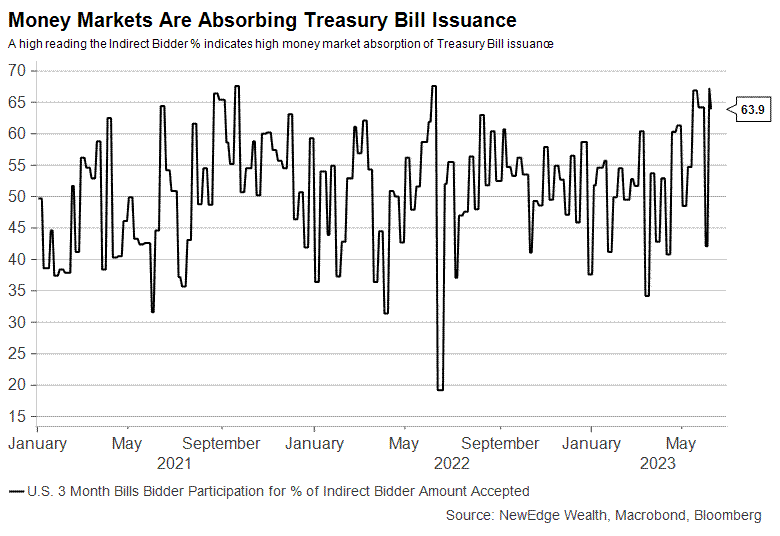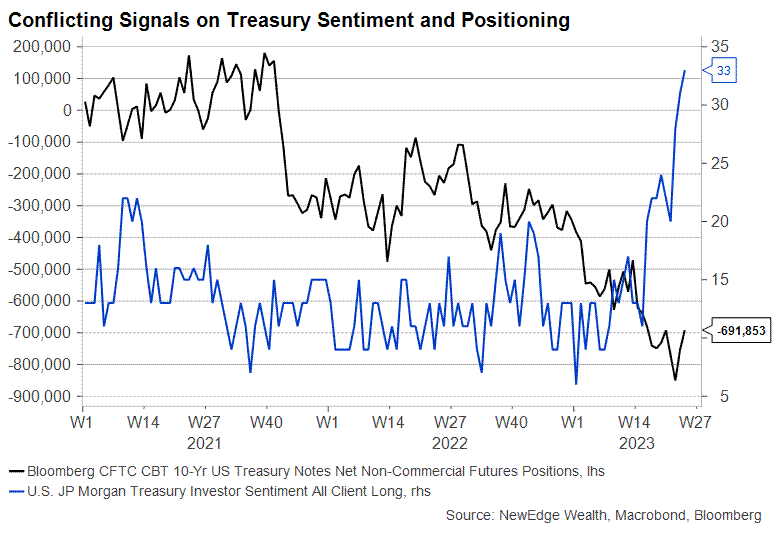Financial markets are in a “risk on” mood. Despite the Fed’s communication that it is tightening policy, liquidity has become more abundant in 2023, providing a boost to liquidity-sensitive assets, like equities and low-quality credit. The bond market, however, remains more cautious as seen from rangebound yields and inverted yield curves. Investors must monitor different indicators of liquidity and how the change in those could suddenly reverse the optimism in markets. We explore these trends in the charts below.
1. The Liquidity Lurch: Now that the debt ceiling resolution has been passed, the US Treasury is tasked with refilling its General Account at the Federal Reserve (the “TGA”). The TGA balance has increased by ~$90 billion since early June. The balance may increase by $700 billion-$1 trillion, issued mainly in Treasury Bills. A concern is that such large issuance ‘drains’ the liquidity from the financial system as the Fed offsets the TGA balance with a decline in reserve balances, which in turn could strain commercial banks’ funding.

2. T-bill Deluge: According to the data from the Securities Industry and Financial Markets Association (SIFMA), on average $800 billion is sold annually in T-bills. The Treasury has issued around $50 billion in net terms since early June. The net issuance is calculated as the gross issuance minus T-bills that are maturing. The demand from money market funds for T-bills has been high as seen from their participation in auctions. This is measured by the indirect bidder percentage which has risen to 63%, the highest since 2021. The flood of T-bill issuance has so far been well absorbed by money market funds, limiting the potential negative effect of draining liquidity.

3. Watch the Money Part 1: Each week the Federal Reserve releases data about the balance sheet, the bank reserves, and lending. There are several indicators to watch for how liquidity may change. One of those is the reverse repos, which is how money market funds earn interest at the Fed. The total outstanding reverse repos declined below the $2 trillion mark and that is (to an extent) offsetting the decline in bank reserves. In fact, since early June, bank reserves have increased by $150 billion.

4. Watch the Money Part 2: The Bank Term Funding Program (BTFP) is a new lending facility the Fed launched in March in response to the crisis around Silicon Valley Bank. The BTFP has risen above $100 billion. Thus far, it has had the opposite effect on financial markets than what was anticipated. Regional banks do not view the BTFP as a stigma and that calmed concerns about financial contagion. The BTFP may grow further in size and that is an indication that bank lending to the economy is contracting. The Fed may at some point skip another meeting to assess the impact of a contraction in credit on the economy. Markets are viewing this as a possibility of a lengthier pause in tightening policy. As such, the S&P 500 has been rising in sync with the increase in the BTFP program.

5. Liquidity seeks its way quickly: A result of the “perception” of abundant liquidity is that investors quickly turn to risk-taking. It has a powerful effect on opening capital markets, especially in frozen parts such as Initial Public Offerings (IPOs). Since April, the S&P IPO index and the Renaissance IPO ETF have moved higher quite fast as investors found a new appetite for companies coming to the market, such as the recent Cava IPO, which rose sharply in its first days of trading.

6. Bond market caution: The bond market is still flashing signals that recession risks remain. The New York Federal Reserve publishes a recession indicator based on the yield curve. The metric flags a 70% probability of a recession in the next 12 months. The yield curve inversion (when short term yields are higher than long term yields) has had wide variation in predicting the timing of a recession. Economic data has yet to confirm an impending recession.

7. Bond market division: Despite the economy potentially teetering to a downturn, bond market investors divided. On the one hand, surveys by JP Morgan shows their clients are “long” U.S. Treasuries. On the other hand, Treasury futures commitment data such as those published by the Commodity Futures Trading Commission (CFTC), shows an increase in short positioning. While each survey lacks a complete and accurate read of how the bond market is positioned, the divergence between longs and shorts is indicating an increasingly divided view over the state of the economy, inflation, and the Fed. As a result, bond yields have been rangebound and may stay so until there is clarity.

8. The Junkier, the better: At the other end of the universe is the junk bond market which has displayed an unusual calm in the face of recession fears. The speculatively and lowest rated sectors, “Triple C’s” (CCC), have displayed remarkably strong performance on the back of equity resilience. The CCC index has posted a 9% total return and the Option Adjusted Spread (“OAS”) has fallen well below 1000 basis points (a lower spread indicates more comfort and appetite for lenders to lend to risky companies). Thus, the junkiest part of the bond market does not see a recession. Of course, this benign view may be influenced by the sudden abundance of liquidity and risk appetite spilling into markets.

9. Cash is still a King: The Federal Reserve’s projections and speakers continue to message that higher rates are coming. For investors, it means that the “reinvestment risk”, the risk of reinvesting maturing bonds at a lower yield, is pushed out in the future as rate cuts are, for now, off the table. The Investment Company Institute reported the first outflows from money markets since the middle of last year. A first crack in the $5.4 trillion cash pile may be appearing as investors seek out the stock market. Yet, retail government-only funds that almost exclusively invest in T-bills are seeing inflows, which shows that cash is still king as the Fed keeps rates high for longer.

10. Central Bank Divergence: A theme that emerged this week is “central bank divergence.” After the Australian, Canadian, and European central banks hiked but the Fed skipped and the Bank of Japan and People’s Bank of China continued easing, there was a divergence in bond yields. At times, interest rates can deviate as a sign that the global tightening cycle is becoming less synchronized.

Top Points of the Week
By Ben Lope

1. Global equities higher – Within US equities, large cap growth names retook the lead from value and small caps as the enthusiasm surrounding artificial intelligence and a Fed pause pushed US indices higher. The NASDAQ and Russell 1000 growth indices notched weekly gains close to 4%, while the Russell 2000 and Russell 2000 value clung to modest, sub-1% gains. Led by China and Japan, shares of international equities were higher on the week as well.
2. Yield curve inversion increases – The yield curve measured by the spread between 2-year and 10-year Treasury yields reached its most inverted level since March, breaching 90bps. The movement occurred primarily on the short end of the curve, with 2-year yields increasing by about 10bps while 10-year yields remained steady, despite intraweek swings brought about by market reactions to an encouraging May CPI print, a Fed pause, and a second straight elevated initial jobless claims reading.
3. Crude oil higher, but energy stocks lower – Price for Brent and WTI crude oil increased north of 2% on the week, although the S&P Energy sector recorded a modest weekly decline amid a year that has seen extensive outflows from ETFs tracking the sector. Earlier this week Goldman Sachs decreased their end of year price target for Brent crude oil by 10%, down to $86/bbl, as the recent news of Saudi Arabia’s production cut may not be enough to offset the outlook for softer global demand.
4. Federal Reserve pauses rate hikes at June meeting – The Federal Reserve’s June meeting culminated in the decision to hold interest rates steady. This pause was broadly anticipated by markets and marks the first such break since the Fed began hiking rates in March 2022, beginning a path that involved 10 straight interest rate increases and lifted rates from just above the zero bound to between 5% and 5.25%. Updated Fed forecasts released in conjunction with the policy rate decision revealed that the central bank expects to hike rates two more times this year, as full year GDP and inflation growth estimates were revised upward, while unemployment estimates were lowered.
5. May CPI figures show lowest headline reading in two years – The release of May inflation data was the second biggest economic event behind the Fed’s two-day policy meeting and offered some encouraging signs that while inflation remains stubbornly high, it is well of its 2022 highs. May headline CPI rose 4% YoY, the lowest YoY inflation reading in two years, and 0.1% MoM. Core CPI notched more elevated figures, with a YoY increase of 5.3% and MoM increase of 0.4%. The gap between the headline and core figures is largely due to the drop in energy prices over the past year, which influences the headline but not the core figures.
6. May PPI shows slowing producer inflation – One day after the generally encouraging May CPI report, the release of May PPI figures struck a similar tone, with annual inflation on prices seen by producers coming in at the lowest level in over two years. May’s report revealed that headline PPI increased by 1.1% YoY and fell 0.3% MoM. The disinflation apparent in this report contributed to the near certainty by market participants that the Fed would pause rate hikes at their June meeting (a prediction that was validated) and is fueling hopes that the Fed may not need to hike two more times before year-end, as the median forecast on the dot plot currently suggests.
7. UMich Consumer Survey shows increased confidence and decreased inflation expectations – The University of Michigan’s consumer sentiment index rose to a four-month high in June with a reading of 63.9. Beyond collecting data necessary for the construction of the consumer sentiment index, UMich’s survey track’s consumer inflation expectations over the short and longer term, which are key pieces of data in tracking how well the Fed’s policy actions and messaging are anchoring inflation expectations. The news on this front is mostly positive, as one year inflation expectations dropped from 4.2% in May to 3.3% in June, and five-year inflation expectations remained at 3%.
8. China stimulus revs up, boosting domestic shares – Chinese officials are enacting stimulus measures to combat a recent spate of economic figures that have cast the strength of China’s post-covid recovery into doubt. Earlier this week China’s central bank cut their policy rate, with the government further considering expansionary measures within the infrastructure and property sectors. Broad Chinese equities were up over 2.5% on Friday following the news of these measures, the true efficacy of which remains to be seen.
9. ECB hikes rates while BoJ stays on pause – On Thursday the ECB hiked their key policy rate by 25bps and signaled that they are “not thinking about pausing,” while countering recent signs that European inflation is cooling with elevated forecasts for full year inflation. Another major global economy, Japan, is following a starkly different, albeit completely expected path. Japan’s central bank chose to hold rates at their current (negative) level despite domestic inflation running well above the bank’s target level for over a year now.
10. Economic events next week – The economic calendar for next week is relatively muted. Markets are closed on Monday to celebrate Juneteenth, but the first half of the week will see the release of key housing data, while the latter half of the week will reveal information regarding employment, leading economic indicators, and flash readings for June manufacturing and services PMIs.
IMPORTANT DISCLOSURES
Abbreviations: Brent blend: a blend of crude oil extracted from oilfields in the North Sea between the United Kingdom and Norway. It is an industry standard because it is “light,” meaning not overly dense, and “sweet,” meaning it’s low in sulfur content; CPI: Consumer Price Index; ECB: European Central Bank; Flash PMI: an early estimate of the Services Purchasing Managers’ Index (PMI) for a country, designed to provide an accurate advance indication of the final services PMI data; PPI: Producer Price Index; Treasury General Account (TGA): Treasury’s cash balance held at the Fed; University of Michigan Consumer Sentiment Index: a survey of personal consumer confidence in economic activity, which is used to estimate future spending and saving; West Texas Intermediate (WTI) Crude: refers to a grade or a mix of crude oil, and/or the spot price, the futures price, or the assessed price for that oil; colloquially WTI usually refers to the price of the New York Mercantile Exchange WTI Crude Oil futures contract or the contract itself.
Index Information: All returns represent total return for stated period. S&P 500 is a total return index that reflects both changes in the prices of stocks in the S&P 500 Index as well as the reinvestment of the dividend income from its underlying stocks. Dow Jones Industrial Average (DJ Industrial Average) is a price-weighted average of 30 actively traded blue-chip stocks trading New York Stock Exchange and Nasdaq. The NASDAQ Composite Index measures all NASDAQ domestic and international based common type stocks listed on the Nasdaq Stock Market. Russell 2000 is an index that measures the performance of the small-cap segment of the U.S. equity universe. MSCI International Developed measures equity market performance of large, developed markets not including the U.S. MSCI Emerging Markets (MSCI Emerging Mkts) measures equity market performance of emerging markets. Russell 1000 Growth Index measures the performance of the large- cap growth segment of the US equity universe. It includes those Russell 1000 companies with relatively higher price-to-book ratios, higher I/B/E/S forecast medium term (2 year) growth and higher sales per share historical growth (5 years). The Russell 1000 Value Index measures the performance of the large cap value segment of the US equity universe. It includes those Russell 1000 companies with relatively lower price-to-book ratios, lower I/B/E/S forecast medium term (2 year) growth and lower sales per share historical growth (5 years). The BBB IG Spread is the Bloomberg Baa Corporate Index that measures the spread of BBB/Baa U.S. corporate bond yields over Treasuries. The HY OAS is the High Yield Option Adjusted Spread index measuring the spread of high yield bonds over Treasuries. Sector Returns: Sectors are based on the GICS methodology. Returns are cumulative total return for stated period, including reinvestment of dividends.
The views and opinions included in these materials belong to their author and do not necessarily reflect the views and opinions of NewEdge Capital Group, LLC.
This information is general in nature and has been prepared solely for informational and educational purposes and does not constitute an offer or a recommendation to buy or sell any particular security or to adopt any specific investment strategy.
NewEdge and its affiliates do not render advice on legal, tax and/or tax accounting matters. You should consult your personal tax and/or legal advisor to learn about any potential tax or other implications that may result from acting on a particular recommendation.
The trademarks and service marks contained herein are the property of their respective owners. Unless otherwise specifically indicated, all information with respect to any third party not affiliated with NewEdge has been provided by, and is the sole responsibility of, such third party and has not been independently verified by NewEdge, its affiliates or any other independent third party. No representation is given with respect to its accuracy or completeness, and such information and opinions may change without notice.
Investing involves risk, including possible loss of principal. Past performance is no guarantee of future results.
Any forward-looking statements or forecasts are based on assumptions and actual results are expected to vary from any such statements or forecasts. No assurance can be given that investment objectives or target returns will be achieved. Future returns may be higher or lower than the estimates presented herein.
An investment cannot be made directly in an index. Indices are unmanaged and have no fees or expenses. You can obtain information about many indices online at a variety of sources including: https://www.sec.gov/fast-answers/answersindiceshtm.html.
All data is subject to change without notice.
© 2024 NewEdge Capital Group, LLC





